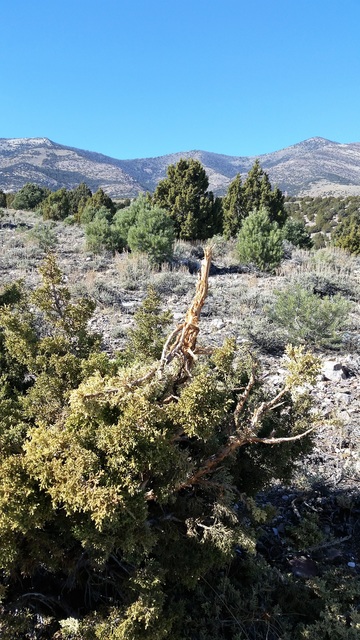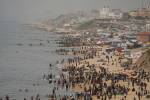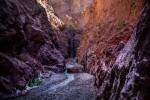Elk hunting can take months of preparation, stamina


My companions and I had been hiking for a couple of hours when we stopped to rest where the remnants of what was once a two-track road pass through a handful of juniper and pinyon pine trees. Even though it was still dark, unseasonably warm temperatures combined with the cross-country travel had sweat running down my face.
It should have been much colder.
The hike hadn’t been especially brutal, but the climb was steady enough to make my heart and lungs earn their keep. I was ready for the break. It was Wednesday morning in early November, the third day of my Nevada bull elk hunt, and I was already hoping for a miracle.
Though I started hunting in earnest the Monday prior, my hunt had its beginnings in late May when Paul, one of my two hunting companions, sent a text informing me I had drawn a bull elk tag for Area 22. His message caught me by surprise because I didn’t anticipate drawing an elk tag. I turned to my wife and said, “I have to lose some weight.”
A few days later, I began an exercise regimen that started with morning walks that soon turned into hikes in the nearby hills. By October, I was wearing my hunting pack, gradually adding gear and water until it was at full hunting weight. I lost 40 pounds by opening day. Less than I hoped for but not bad.
Almost seven years ago, I survived a pulmonary embolism while ice fishing in Utah. The pulmonologist warned me then that my days of chasing big game around at high elevations for a week at a time were done, that my body no longer could sustain such activity. His prognosis is always in my mind, but I was hoping for the best and that my preparation would be enough.
Our plan was to hunt the benches of Mount Grafton, where open ridges meet the base of its steep slopes. It was here that Don, the third member of our group, had seen bulls while hunting elk with another friend during the 2015 elk season.
After setting up camp on Friday, we spent the afternoon glassing the benches. Eventually we spotted a handful of bulls scattered across a rather large area. Though we didn’t see anything that stood out, there was one bull that was worth getting a closer look at. He was feeding on a small shelf with a couple of others and then faded into the trees before dark.
Don and I spent Saturday hiking through some good-looking country to the south of camp but saw only small bulls. We put several miles behind us, but I felt good. On Monday, we got an early start and headed for the bench below the shelf. As time passed, Don and I saw a couple of small bulls as they ghosted their way through a thick stand of trees, but that was all we saw.
Later that afternoon, we found a good vantage point overlooking the shelf where we had seen the bulls on Friday. We settled in and started glassing, hoping to see the bulls feeding their way back onto the shelf. For a while all was quiet, then suddenly I heard someone talking. At first the sound seemed distant, but over time it grew steadily louder. Then I looked in the draw between us and the shelf. Sure enough, there were two guys standing there having a conversation. They were soon joined by someone leading a string of llamas.
So much for the afternoon hunt.
On Tuesday, we spent the day hunting and then exploring an old burn where Don had seen a nice bull during the rut. There we saw nothing but elk tracks and feral horses. Between the warm temperature and the moonlit nights, the elk seemed to be moving only in the dark, the fear of everyone who hunts elk.
As the sun lighted the sky on Wednesday, we began glassing the slopes from our resting spot on the old two-track. Don soon found a group of bulls feeding high above us on a bald knoll. One was a good bull with long tines and good main beams. How much would it score? I couldn’t care less. It was simply a pretty bull.
We charged up the old road to where it narrows down to a trail. I couldn’t keep up with Don, so he took my pack and carried it for me. I found a bare tree and used one of its limbs as dead rest. Three bulls stood on the top of the steep knoll, and they all knew we were there.
“It’s the one on the left,” Don whispered.
It would be a long shot. I found the bull in my scope and squeezed the trigger. The bull didn’t move. I missed. I fired three more times, but all were misses. And I couldn’t tell whether I was hitting high or low. By then, the bulls grew weary and disappeared in a stand of trees. Paul and I made our way to a knob overlooking the trees while Don hiked up and verified the misses. Then we settled in to wait for the bulls to feed back up out of the trees that afternoon, but we didn’t see them again.
The next morning, as we hiked back up toward the shelf, it became apparent that my legs were gone and my breathing became labored. I became concerned, and so did my companions. The doctor’s prognosis had proven true. We finished the morning by hunting the bench below the shelf. Don spotted two small bulls and tried to push them my way, but I never saw them. It always amazes me how such a large animal can be virtually invisible.
On Friday, we drove through some new country looking for the bull that made a mistake, but we didn’t find him. That afternoon we headed for home. Luckily I still have some venison in my freezer, but now I need to figure out how to mount an unpunched elk tag.
Freelance writer Doug Nielsen is a conservation educator for the Nevada Department of Wildlife. His “In the Outdoors” column, published Thursday in the Las Vegas Review-Journal, is not affiliated with or endorsed by the NDOW. Any opinions he states in his column are his own. He can be reached at intheoutdoorslv@gmail.com.


















